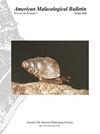两种悬浮摄食双壳类软体动物表面特性对颗粒捕获的影响
IF 0.4
4区 生物学
Q4 MARINE & FRESHWATER BIOLOGY
引用次数: 19
摘要
摘要:悬浮摄食双壳类软体动物辨别颗粒摄食的能力是众所周知的。颗粒的物理化学性质已被证明在这些动物中介导捕获后选择中起作用。特别是,颗粒表面电荷和润湿性(疏亲水性的代表)可以被不同的双壳类用作选择的决定因素。然而,粒子的物理化学因素如何影响它们的捕获却很少被研究。为了研究这种相互作用,设计了一系列粘附试验和粒子捕获实验。首先,分别分离蓝贻贝Mytilus edulis (Linnaeus 1758)和海湾扇贝Argopecten irradians (Lamarck 1819)的鳃粘液,将其吸附在玻璃载玻片上,并与未经处理或共价结合不同新糖蛋白的聚苯乙烯微球(10 μm)培养。n -乙酰氨基葡萄糖,d -甘露糖),或牛血清白蛋白(BSA)。将处理过的微球与未处理过的微球对有黏液和没有黏液的载玻片的粘附量进行量化和统计比较。其次,将未经处理的微球和NGP和BSA共价结合的微球(直径为2 ~ 10 μm)直接送入双壳类动物的电流孔;对出水进行了采样,并计算了捕集效率(CE)。结果表明,外颗粒BSA和NGP的存在可以显著改变微球的表面特征,但这些差异对黏液或CE的粘附性影响很小。一个明显的例外是,与相同大小的对照球相比,经d -甘露糖处理的直径为2和3 μm的微球在贻贝体内的CE显著降低。总的来说,本研究的结果表明,贻贝和扇贝可以有效地捕获具有一系列物理化学表面性质的颗粒。这些发现符合先前报道的颗粒表面性质对悬浮捕食双壳类幼虫颗粒CE的影响,而不是沉积捕食者的影响。本文章由计算机程序翻译,如有差异,请以英文原文为准。
Effects of Surface Properties on Particle Capture by Two Species of Suspension-Feeding Bivalve Molluscs
Abstract:
The capabilities of suspension-feeding bivalve molluscs to discriminately ingest particles are well known. Physicochemical properties of particles have been shown to play a role in mediating post-capture selection in these animals. In particular, particle surface charge and wettability, a proxy for hydrophobic-hydrophilic forces, can be used by different bivalve species as determinants of selection. How physicochemical factors of particles affect their capture, however, have been little studied. To investigate such interactions, a series of adhesion assays and particle capture experiments were designed. First, mucus from the gills of the blue mussel, Mytilus edulis (Linnaeus 1758), and the bay scallop, Argopecten irradians (Lamarck 1819), were isolated separately, adsorbed onto glass microscope slides, and incubated with polystyrene microspheres (10 μm) that were either untreated or covalently bound to different neoglycoproteins (NGP; N-acetyl-glucosamine, D-mannose), or bovine serum albumin (BSA). Adhesion of treated and untreated microspheres to slides with and without mucus was quantified and statistically compared. Secondly, untreated microspheres and spheres with covalently bound NGP and BSA (ranging from 2 to 10 μm in diameter) were directly delivered to the incurrent aperture of bivalves. The excurrent water was sampled, and capture efficiencies (CE) calculated. Results demonstrate that the presence of epiparticulate BSA and NGP can significantly change the surface characteristics of microspheres, but these differences had minimal effect on adhesion to mucus or CE. A notable exception was a significant reduction in CE of D-mannose-treated 2- and 3-μm diameter microspheres by mussels compared to the control spheres of the same size. Overall, results of this study suggest that mussels and scallops can efficiently capture particles with a range of physicochemical surface properties. These findings conform to previously reported effects of particle surface properties on CE of particles by suspension-feeding bivalve larvae, but not deposit feeders.
求助全文
通过发布文献求助,成功后即可免费获取论文全文。
去求助
来源期刊
CiteScore
1.00
自引率
40.00%
发文量
1
审稿时长
>12 weeks
期刊介绍:
The American Malacological Bulletin serves as an outlet for reporting notable contributions in malacological research. Manuscripts concerning any aspect of original, unpublished research,important short reports, and detailed reviews dealing with molluscs will be considered for publication. Recent issues have included AMS symposia, independent papers, research notes,and book reviews. All published research articles in this journal have undergone rigorous peer review, based on initial editor screening and anonymous reviewing by independent expertreferees. AMS symposium papers have undergone peer review by symposium organizer, symposium participants, and independent referees.

 求助内容:
求助内容: 应助结果提醒方式:
应助结果提醒方式:


